
A study released earlier this month by market research firm Forrester predicted that automation (robots) will kill 24.7 million U.S. jobs by 2027. The firm concluded that automation and other developing technologies will create 14.9 million new jobs in that same time frame. That’s still a net loss of nearly 10 million jobs. Customer service, manual labor and complex calculation tasks are the most at-risk.
Writing would seemingly be the last jobs robots take over because of “human exceptionalism.” Emotional nuances, cognizance and other human faculties are ostensibly unique to homo sapiens. People craft words that resonate with other people. Star Wars fans remember when Luke Skywalker first met C3PO in The New Hope. Luke asked C3PO about some of the battles he’s seen between the Rebellion and the Empire. But C3PO was programmed only to be a language interpreter. He did not have the functional capacity to tell a story. C3PO apparently received more advanced programming in Return of the Jedi. He sure told the Ewoks a compelling story.
Artificial intelligence technology in 2017
There are already robots writing certain types of copy. The practice is growing in scope. Daryl Plummer, managing vice president and chief researcher at Gartner, said at the company’s Symposium/ITxpo 2016 in Orlando that robots will author 20% of business content by 2018. Budget reports and quick recaps of sporting events are currently the most common types of content written by artificial intelligence (AI).
Financial writers combed through 10-K, 10-Q and other SEC earnings reports in the old days (meaning a few years ago). They took notes in the margins and even did audio narratives of their weeks-long absorption of these textbook-like documents. Some 10-K and 10-Q reports for large companies easily exceed 100 pages of headache-inducing, cryptic blather. Writers translated the garble and wrote articles that regular readers could understand.
The Associated Press (AP) reported in January of 2015 that it previously wrote about 300 articles per quarter about corporate earnings. The tasks was too tedious to assign much more to financial journalists. The AP formed partnerships with Automated Insights, Inc. and Zacks Investment Research in late 2014. Automated’s natural language generation platform called Wordsmith, combined with Zacks’ research and analytics, enabled the AP to published 3,000 such articles in one quarter. That’s a ten-fold increase in production.

Artificial intelligence and copywriting in 2017
Automated Insights was purchased by venture capital firm Vista Equity Partners in early 2015. Vista also owns Stats LLC. Fantasy sports players recognize the name Stats LLC. as one of the industry leaders in providing real-time scoring for their leagues. The partnership is only scratching the surface as to its capabilities. Stats’ huge vault of sports data and Insights’ AI technology provide endless opportunities.
Scientists at the International Institute of Information Technology (IIIT) in Hyderabad, India, also married sports and AI in late 2015. A robot “watched” hundreds of taped cricket matches on the ESPNcricinfo website. It also watched the Indian Premiere League channel on Youtube. The robot learned via word association. It matched actions on the screen and players’ names with the announcers’ commentary. The computer taught itself an algorithm to write its own real-time commentary during live games. It was 90% accurate in its commentary. Robots have also tried their hand at writing movie scripts. But the end results didn’t exactly impress the Academy of Motion Picture Arts and Sciences.
Successful writers are perpetually adapting to the ever-changing landscape of SEO and content marketing. It comes with the territory for those who wish to remain in the industry. The expansion of AI is simply another challenge writers must accept.

Sports and financial writers’ jobs at risk?
Robots have the ability to view box scores and write intelligible summaries about the game. Fox Sports and Yahoo! have been generating this type of content with AI for several years now. Chicago-based Narrative Science is leasing its natural language generation platform called Quill to financial firms like Credit Suisse and T. Rowe Price. It writes performance reports on mutual funds, hedge funds, and stocks.
The days of sports writers sitting in press boxes, collecting stat sheets from team personnel, and writing recaps after games are likely numbered because of AI. But robot commentators won’t be doing play-by-play for basketball, football and ice hockey anytime soon. Opinion journalism is the norm in professional and amateur sports. That gives human writers the edge over machines.
Sports and financial writers have adapted to this reality. Job security and fierce competition are forcing their hands. Financial writers used to let the numbers speak for themselves. But a human touch is essential in the fast-paced 21st century. It distinguish them from both machines and their human competition.
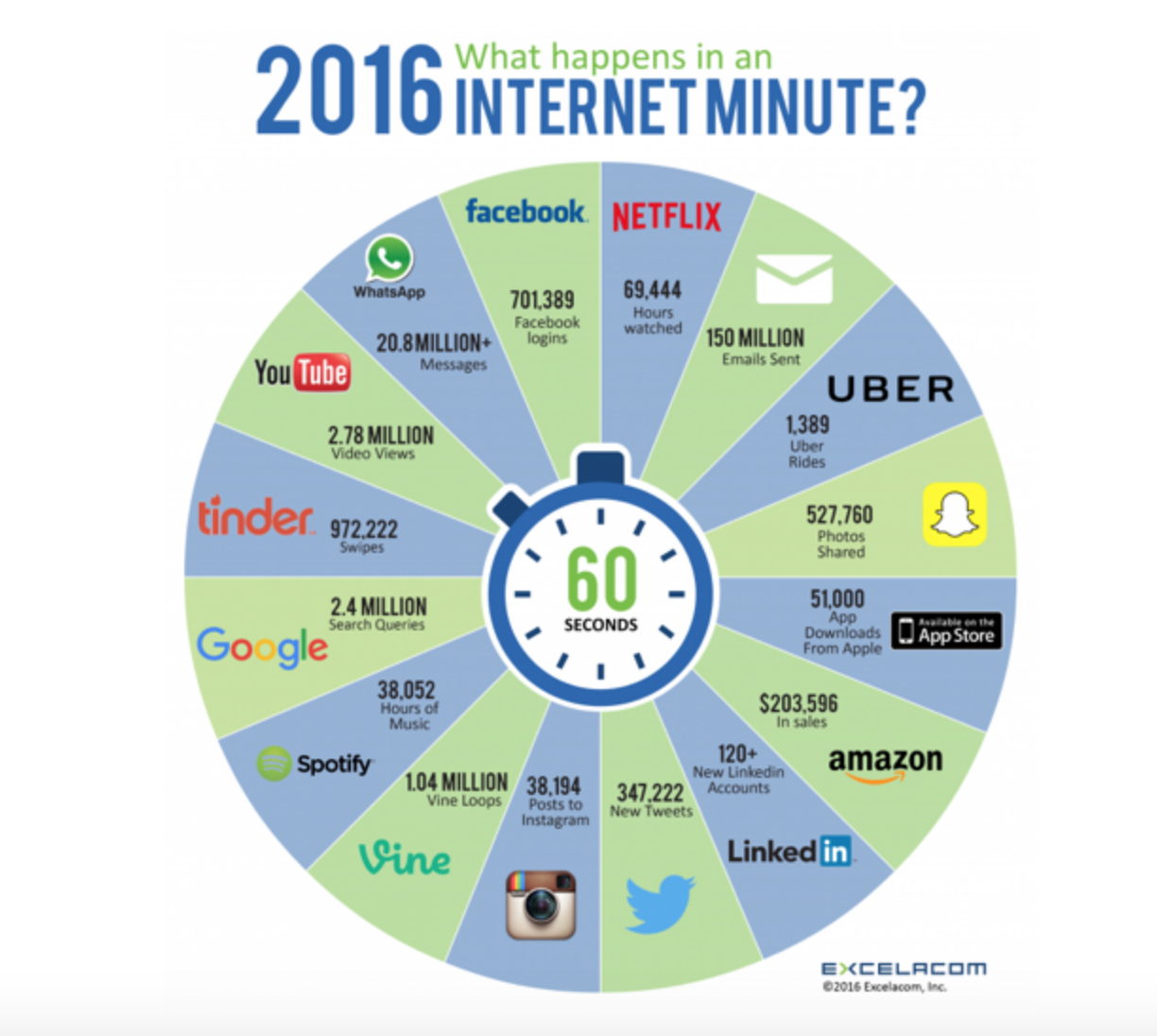
Artificial intelligence isn’t cheap
Automation is on the wish lists of many companies. It streamlines workflows and significantly reduces the time it takes to complete certain tasks. The reality is that AI is cost prohibitive for most businesses.
The legal industry is bullish on AI for its potential money and time-saving capabilities. But Connie Brenton, chairman of the board at the Corporate Legal Operations Consortium, is more skeptical. She told law publication Corporate Counsel in February that AI is not a “silver bullet” that will disrupt the legal profession overnight. Brenton elaborated at Legalweek: The Experience 2017 Conference. She noted that initial costs exceed six-figures in many cases. There is also a 5-6 month time investment before virtual assistants are ready for implementation into legal workflows. Full-time administrators must be hired to maintain the system. Frequently consultation with the AI vendor is also necessary.
Seth Earley, CEO of Earley Information Science, agreed that cost and time investment eliminate AI as a realistic option for most companies in the near term. Earley suggested via Harvard Business Review that the more realistic option for small and medium-sized companies is what he termed “AI Lite” systems. They lack cognitive computing ability. AI Lite is programmed to complete only certain tasks. These systems require additional coding to learn new tasks. But AI Lite is scalable. It provides a foundation for companies as the technology becomes more affordable and accessible.
Breathe easy, writers

Financial writers had job security because few people understand economic regulations, indexes and statistics enough to compose compelling stories. AI is already impacting that segment of writers. The journalistic aspect of financial writing is still a human activity. Interviews with industry experts, CEOs, etc. provide perspective to readers. Journalists have difficulty contacting sources on the phone and/or via email to get direct quotes. Its doubtful CEOs and market analysts are willingly to talk to robots on the phone or via email versus responding to another human being.
AI is everywhere in 2017. The trend is not slowing down whether humanity likes it or not. Robots drive some cars today. But 75% of Americans and a majority of Europeans are afraid of autonomous technology. They would rather drive themselves. An Indiegogo virtual sex robot campaign was suspended because demand was so high. But most (normal) people still favor sex with other humans, not robots.
A 1940s experiment also proved human touch is vital to human life. Note this was before the United States had medical ethics. One group of caretakers was ordered to hold, look at, talk to, etc. a group of babies. The other group only changed the baby’s diapers and fed them. They excluding all physical contact, communication, etc. The experiment ceased after four months. Four of the babies that received no human contact died. Two more died months later even with real parental care thereafter.
Artificial intelligence not ready for prime time
AI is presenting writers the opportunity to better themselves. Writers must be subject matter experts in more industries. They must acquire new skills like graphic design, web design and/or SEO. Writing is innately a human form of communication. It requires humans to craft and subsequently appreciate.
Professional writers know the basics: cite primary sources, use keywords in headlines, hit deadlines, etc. But most importantly, give your writing that human touch. Humans understand and appreciate other human experiences. Adapt or be replaced. It’s as simple as that.


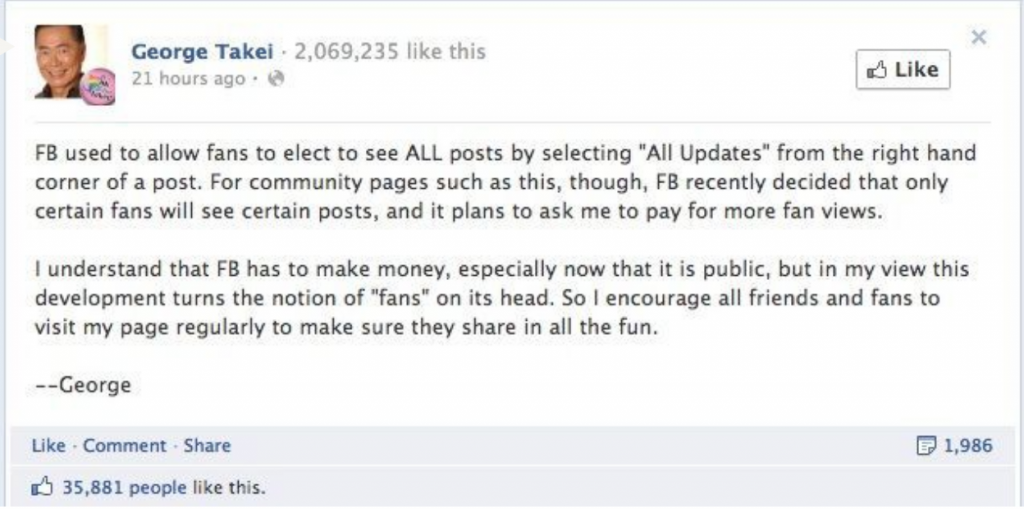 A Facebook employee responded to Takei, saying the company had not changed anything about the way posts were disseminated. Instead, according to the employee, Facebook made the user experience better by making the content they see more relevant. But Takei was not satisfied with the explanation, as he posted a very similar note several months later.
A Facebook employee responded to Takei, saying the company had not changed anything about the way posts were disseminated. Instead, according to the employee, Facebook made the user experience better by making the content they see more relevant. But Takei was not satisfied with the explanation, as he posted a very similar note several months later.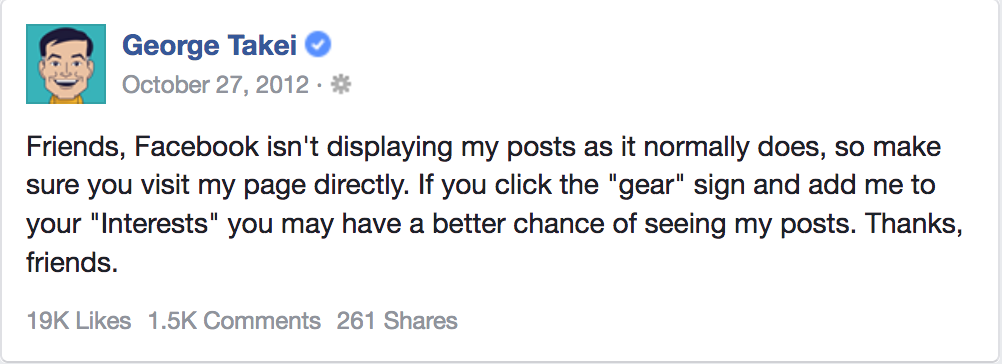 Billionaire Mark Cuban, who owns the NBA’s Dallas Mavericks, talked about the changes to Facebook business pages in November of 2012. The team posted a promo for an upcoming game on Facebook assuming it would reach a large percentage of its 2.3 million followers at the time. The post only reached 27,000 of the Mavericks’ followers organically (or about 1.1%). Cuban tweeted his assessment of Facebook, along with a screenshot of Facebook demanding $3,000 for the Mavericks to reach about half of their followers (NOTE: the tweet has since been deleted).
Billionaire Mark Cuban, who owns the NBA’s Dallas Mavericks, talked about the changes to Facebook business pages in November of 2012. The team posted a promo for an upcoming game on Facebook assuming it would reach a large percentage of its 2.3 million followers at the time. The post only reached 27,000 of the Mavericks’ followers organically (or about 1.1%). Cuban tweeted his assessment of Facebook, along with a screenshot of Facebook demanding $3,000 for the Mavericks to reach about half of their followers (NOTE: the tweet has since been deleted).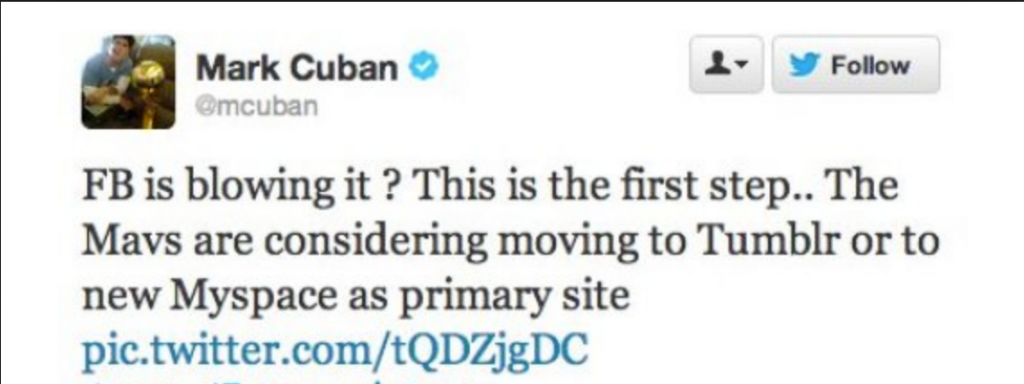


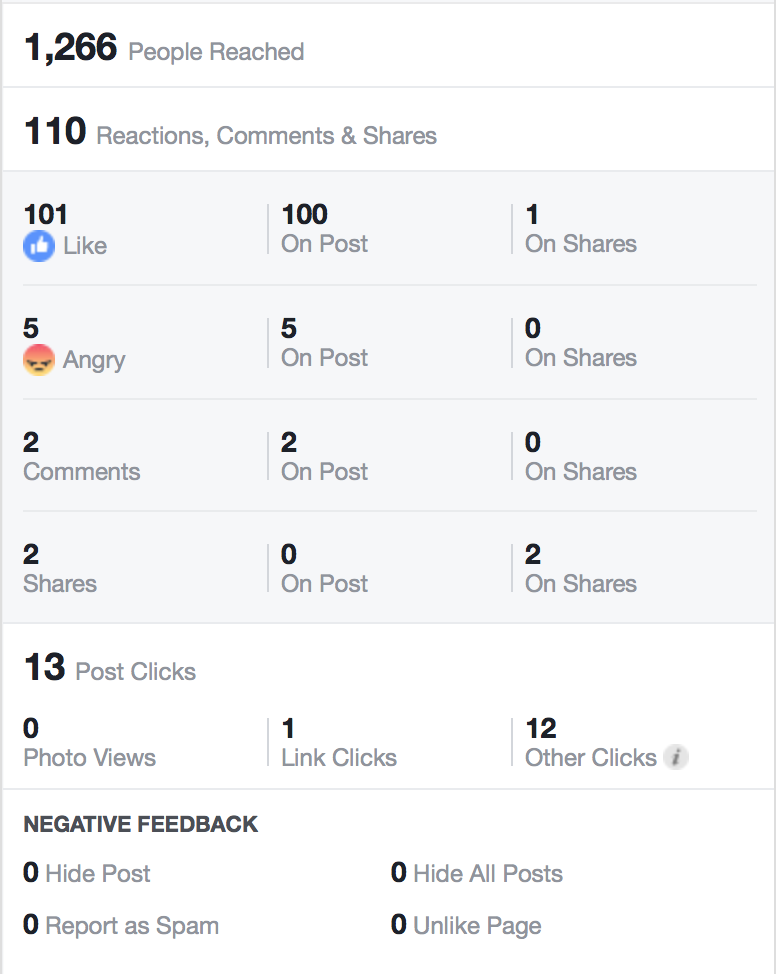
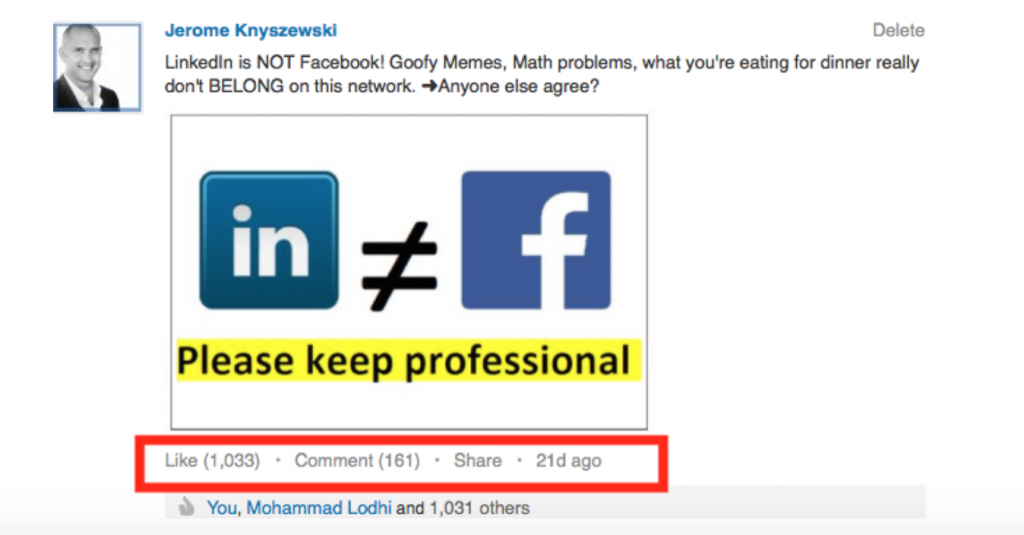




 The company also sells a line of personal hygiene products, including shaving cream and after-shave. But few companies can pull off the edginess Dollar Shave Club does on its blog.
The company also sells a line of personal hygiene products, including shaving cream and after-shave. But few companies can pull off the edginess Dollar Shave Club does on its blog.



